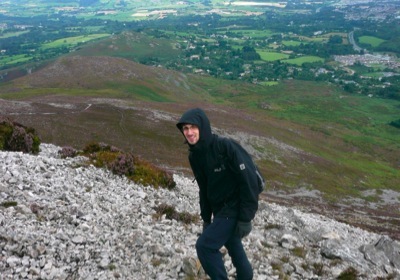Peter Bremen, PhD student
2009
I have studied biology at the RWTH-Aachen. As an undergraduate student I became intrigued by auditory neuroscience when hearing about the barn owl’s astonishing ability to localize prey in total darkness. Therefore, I joined Prof. Dr. H. Wagner to prepare my Diploma thesis in his lab. During my time at Prof. Wagner’s lab I studied the representation of interaural time differences (ITDs) in the barn owl’s core of the central nucleus of the inferior colliculus (ICCc). I employed the virtual auditory space (VAS) technique to demonstrate that ICCc neurons solely respond to ITDs (see Bremen et al. 2007a).
After completion of my Diploma thesis in 2005 I joined Prof. Dr. J. Van Opstal’s lab as a PhD student and SensoPrim fellow. So far my work in Nijmegen includes the advancement of the double magnetic induction (DMI) method (Bour et al. 1984) to allow its application for measurements of head-unrestrained gaze shifts in humans (see Bremen et al. 2007b, 2007d) and laboratory animals. At the moment I am trying to streamline the calibration routine we have described in our most recent paper by employing simulations of the oculomotor system and the resulting DMI signal. Furthermore, together with Dr. Rob Van der Willigen I am involved in porting the knowledge we've gained with human subjects to head-unrestrained laboratory animals. This involves designing a DMI compatible headpost and DMI specific equipment as well as training the animals to perform in an optimized calibration paradigm.
In addition, together with an undergraduate student I am currently working on a project tentatively entitled “Auditory Double Stimuli in Elevation”. The project is inspired by the phenomenon that in oculomotor literature is known as "averaging" (Ottes et al. 1984) or the "global effect" (Findlay 1982) and in the auditory literature as "summing location/phantom source" (see for example Blauert's book). In our daily life we experience the phenomenon called "summing location" when making use of stereo sound systems. When music is played from two loudspeakers we perceive the source of the music to be in the middle of the two speakers. This can easily be explained by the binaural cues that arise due to the spatial separation of the two ears. These cues are used for sound localization in azimuth. However, to localize sounds in elevation we use monaural cues that are due to the filtering of external structures like torso and pinna. In our project we will focus on how the elevation percept is coded in the auditory system. To do this we will investigate the sound localization behavior of human subjects. We will present our subjects with two sound sources at the same azimuthal but different elevational locations. The subject - seated in a dark, sound attenuated chamber - is required to point with his/her head to the perceived location of the sound as quickly and as accurately as possible. The subject's head movements will be measured with the classical coil technique so that the trajectories and kinematics of the head movements can be reconstructed and analyzed offline. With these kind of experiments we hope to contribute to the elucidation of the mechanisms underlying sound source localization in elevation.
Please feel free to contact me if you have any questions about my work. If you are interested in my bio have a look at my detailed CV.
Scientific Background & Current Work

Stats
Email p{dot}bremen{at}donders{dot}ru{dot}nl
University
Address
Room
Phone
Fax
2007
D) Bremen P, Van der Willigen RF, Van Opstal AJ. Applying double magnetic induction to measure two-dimensional head-unrestrained gaze shifts in human subjects. J Neurophysiol. 2007 Dec;98(6):3759-69.
C) Wagner H, Asadollahi A, Bremen P, Endler F, Vonderschen K, von Campenhausen M. Distribution of interaural time difference in the barn owl's inferior colliculus in the low- and high-frequency ranges. J Neurosci. 2007 Apr 11;27(15):4191-200.
B) Bremen P, Van der Willigen RF, Van Opstal AJ. Using double-magnetic induction to measure head-unrestrained gaze shifts. I. Theory and validation. J Neurosci Methods. 2007 Feb 15;160(1):75-84.
A) Bremen P, Poganiatz I, von Campenhausen M, Wagner H. Sensitivity to interaural time difference and representation of azimuth in central nucleus of inferior colliculus in the barn owl. J Comp Physiol A Neuroethol Sens Neural Behav Physiol. 2007 Jan;193(1):99-112.
Please feel free to contact me if you need an electronic copy of any of the above listed articles.
List of Publications
last modified Jan 01 2009
Hiking the Big Sugar Loaf, County Wicklow, Ireland, 2007
-
•Neuronal coding of auditory space
-
•Multi-sensory integration
-
•Sensory-motor integration
-
•Information theoretical approaches to neuronal coding
-
•Efficient coding (Barlow 1961)
-
•Bayesian Decision Theory
Research Interests
Donders Institute for Brain,
Cognition and Behavior
Radboud University Nijmegen
Dept. of Biophysics
Geert Grooteplein N21
6525 EZ Nijmegen
The Nethelands
-1.28
+31 24 3610631
+31 24 3541435
